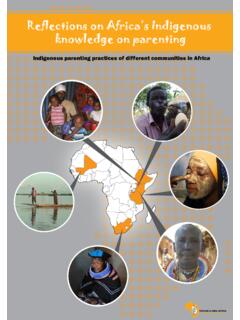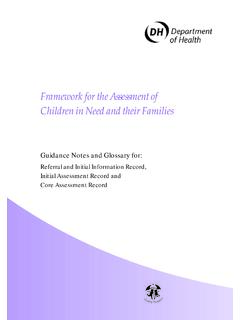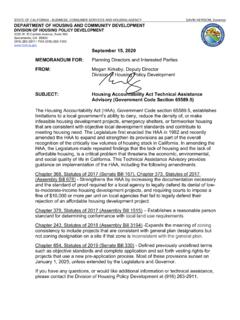Transcription of CORE CONCEPTS AND PRINCIPLES OF EFFECTIVE CASE …
1 CORE CONCEPTS AND PRINCIPLES . OF EFFECTIVE case MANAGEMENT: APPROACHES FOR THE SOCIAL. SERVICE WORKFORCE. GLOBAL SOCIAL SERVICE WORKFORCE ALLIANCE. case MANAGEMENT INTEREST GROUP. 1st Edition, January 2018. TABLE OF CONTENTS. PREFACE and ACKNOWLEDGEMENTS .. 3. GLOSSARY .. 4. INTRODUCTION ..6. HOW WAS THIS GUIDE DEVELOPED? .. 6. WHO IS THIS GUIDE FOR? .. 7. WHAT IS case MANAGEMENT?.. 7. GUIDING PRINCIPLES FOR case MANAGEMENT .. 8. THE STAGES OF case MANAGEMENT .. 10. THE PEOPLE INVOLVED IN case MANAGEMENT .. 12. THE IMPORTANCE OF AND MECHANISMS FOR COORDINATION.
2 12. RESOURCES REQUIRED TO IMPLEMENT A case MANAGEMENT PRACTICE .. 13. SITUATIONS WHERE case MANAGEMENT MAY NOT BE AN APPROPRIATE APPROACH .. 14. CONCLUSION .. 14. REFERENCES .. 15. Core CONCEPTS and PRINCIPLES of EFFECTIVE case Management: Approaches for the Social Service Workforce 2. PREFACE. This document represents the work of the Global Social Service Workforce Alliance (Alliance) case Management Interest Group (CMIG). As a global network, we bring people together to advance knowledge on the latest trends in the field and offer solutions to social service workforce challenges.
3 We support the work of the task-focused and result-oriented groups of the Alliance members concentrated on the topics of their interest. Given increasing interest of the members on the topic of case management and the social service workforce, the Alliance has established and supported the work of the CMIG and its Tools and Resources and CONCEPTS and PRINCIPLES Sub-groups. This document, produced by the CONCEPTS and PRINCIPLES Sub-group, aims to provide a concise description of the concept of case management and the basic ideas or rules that explain, outline or provide guidance on how case management is used and the role of the social service workforce.
4 The CONCEPTS and PRINCIPLES Sub-group was co-chaired by Kelley Bunkers and Khadija Abdulrahim Karama. To see the names of the many people who contributed to the development of this document, please refer to the acknowledgments section. We should note that even given this extensive initial input, this document is in its first edition. Its continued improvement relies on each of you who reads it, uses it or references it. Our hope is that you will let us know ways in which it can become more relevant, more applicable to different contexts and more useful.
5 Thank you to those who have spent considerable time contributing to the development of this document and to those who will do so for future editions. ACKNOWLEDGEMENTS. The Global Social Service Workforce Alliance would like to thank Kelley Bunkers and Khadija Abdulrahim Karama, the co-chairs of the case Management Interest Group CONCEPTS and PRINCIPLES Sub-group for their leadership and technical support. Consultants and staff who supported the development of this document are: Beth Bradford and Elayn Sammon (consultants) and Natia Partskhaladze, Amy Bess and Nicole Brown (staff).
6 We would especially like to recognize the contributions of the following interest group members who provided valuable input into to the development of the document: Florina Balint, Jane Calder, Rebecca Davis, Stephanie Delaney, Nathan Linsk, Samson Radeny, Lucy Steinitz and Francesca Stuer. In addition, other members of the interest group were important contributors to the conceptualization and formation of this work, including: Janet Barry, Aften Beeler, Lauren Bienkonski, Dawn Bowes, Maria Bray, Sr. Cecilia (CRS Zambia), Severine Chevrel, Janet Du Preez, Colleen Fitzgerald, Katie Januario, Neckvilleus Kamwesigye, Sarah Lim Bertrand, Sarah Neville, Hannah Newth, Naomi Reich and Jessica Tabler-Mullis.
7 Core CONCEPTS and PRINCIPLES of EFFECTIVE case Management: Approaches for the Social Service Workforce 3. GLOSSARY. Allied worker These are workers who carry out social service functions but are associated with other sectors such as education, health or justice. Examples include health extension workers and early childhood educators. Those who form the allied workforce perform a myriad of functions that enhance, support or coordinate with those functions carried out by the social service workforce at the micro, mezzo and macro levels.
8 Source: adapted from % case plan Document used to outline step-by-step actions that will be taken to meet the goals of the client. The case plan also includes information such as who is responsible for each step and the timeline for when actions will take place. Sources: adapted from and Para professional The term para is defined as next to or alongside of. The para professional would typically work next to or support the work of a professional in the same field. A para professional worker is trained to perform certain functions, but not always legally certified or licensed to practice as a full professional, which in some fields requires college or university degrees or specialized training (see Professional below).
9 Source: adapted from Para professional social service worker A supervised para professional staff person or volunteer often community-based who serves the needs of vulnerable individuals including children and families, particularly where social welfare systems are underdeveloped or severely stretched. Source: Linsk et al, 2010. Professional Typically denotes membership in a profession that is well recognized, often for the specific degree or level of education that it requires, a particular ethical or moral code of conduct, and/or licensing or certification to practice.
10 Among social service workers, refers to those workers with at least a bachelor's degree in a field directly related to social services, such as social work. Source: adapted from The%20 Composition%20of%20the%20 Social%20 Service% Social service Services provided by public or private organizations aimed at addressing the needs and problems of the most vulnerable populations, including those stemming from violence, family breakdown, homelessness, substance abuse, immigration, disability and old age. Source: Better Care Network Toolkit.














